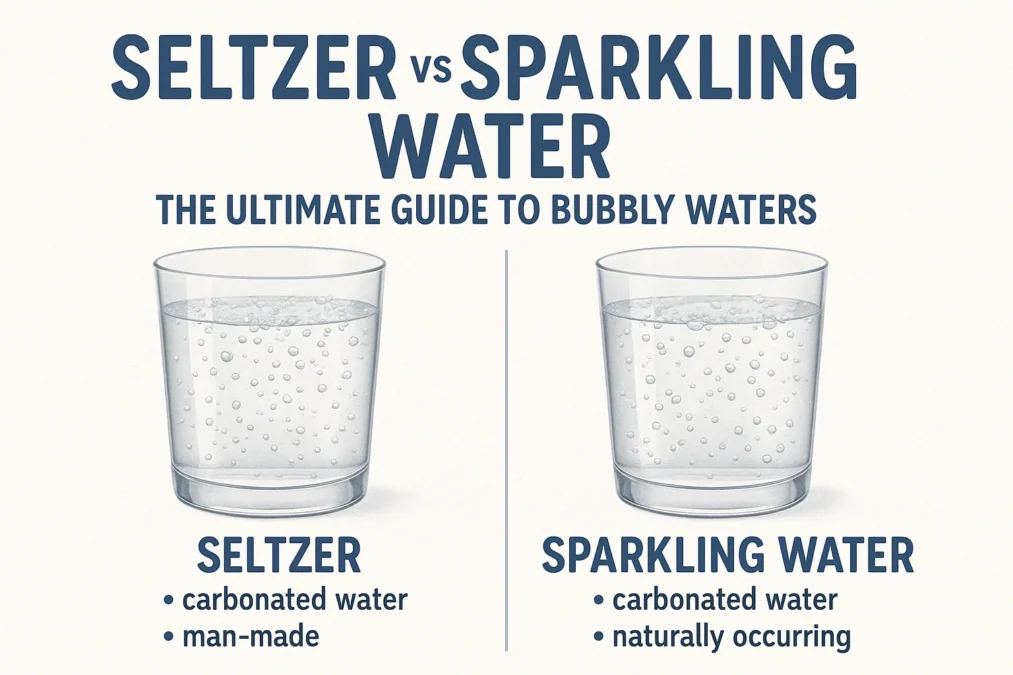You’re standing in the beverage aisle, gazing at a wall of cans and bottles promising crisp, refreshing carbonation. Your eyes dart between labels: Seltzer. Club Soda. Sparkling Water. Tonic Water. Mineral Water. They all fizz, they’re all clear, and they all seem to promise a healthier alternative to soda. But what, exactly, is the difference? For many, the terms “seltzer” and “sparkling water” are used interchangeably, a catch-all for any water that isn’t flat. However, in the world of beverages, these terms have distinct meanings that impact everything from their taste and origin to their place in your favorite cocktail.
Understanding the nuances between seltzer and sparkling water is more than just beverage trivia. It’s about knowing what you’re putting into your body. Are you drinking added minerals for hydration? Are you sipping on a product with natural origins or a scientifically crafted one? Does your choice of bubble affect your dental health? This comprehensive guide will pop the lid off the carbonated water world. We’ll dive deep into the history, production, taste profiles, and health implications of seltzer vs sparkling water, empowering you to make an informed choice the next time you reach for a satisfying, fizzy drink. Whether you’re a casual sipper or a bubble aficionado, this is everything you need to know.
The Core Difference: It’s All About the Source
At the most fundamental level, the great seltzer vs sparkling water debate boils down to one key concept: origin. This single factor dictates everything else about the beverage, from its flavor profile to its mineral content. Think of it as the “nature vs. manufacture” of the carbonated water world.
Sparkling water, in its true form, is a natural product. It begins its life as water from a protected underground source, like a spring or well. This water is already mineral-rich, having filtered through layers of rock, acquiring elements like calcium, magnesium, sodium, and potassium along the way. The carbonation in true sparkling water can also be natural. In certain geological settings, water comes into contact with carbon dioxide gases underground and becomes naturally effervescent. Renowned brands like San Pellegrino and Perrier source their water from such natural springs and then, often, add a touch of extra carbonation after extraction to ensure consistency in bubble level and mouthfeel. The result is a beverage that tastes distinctly of its terroir, with a complex mineral signature.
Seltzer, on the other hand, is a purely human invention. Its story starts with plain, still water—often municipally sourced and purified. There is no natural mineral content to speak of; it’s a blank canvas. Carbonation is then forcefully added under pressure in a factory. The name itself is a historical artifact, deriving from the German town of Selters, which was famous for its natural springs. Early European immigrants to America sought to replicate that effervescent water, and the manufactured product they created kept the name. So, while sparkling water is discovered and then enhanced, seltzer is created from scratch. This fundamental difference in sourcing is the cornerstone of the seltzer vs sparkling water discussion.
A Journey Through Bubbly History
The human fascination with fizzy water is far from a modern trend. It stretches back centuries, long before bottling plants and grocery store aisles. The story of seltzer vs sparkling water is deeply intertwined with geology, science, and evolving consumer tastes.
Natural sparkling mineral waters have been revered since ancient times. The Romans, known for their sophisticated aqueducts and bathhouses, built temples around natural springs, believing the bubbling waters held curative and spiritual properties. They would bathe in and drink from these springs, enjoying the peculiar tingling sensation. Throughout the Middle Ages and Renaissance, these “healing springs” across Europe became destinations for the wealthy and ailing, seeking remedies for everything from digestive troubles to skin conditions. Towns like Spa in Belgium and Selters in Germany became synonymous with these therapeutic waters. This historical association with wellness and natural purity is a legacy that still benefits sparkling mineral water brands today.
The history of seltzer begins with the quest to replicate these prized natural waters. In the 18th century, scientists began to unravel the mystery of carbonation. Joseph Priestley is often credited with inventing the first method for artificially carbonating water in 1767, by suspending a bowl of water above a beer vat and encouraging the infusion of CO2. This scientific breakthrough was later commercialized by Johann Jacob Schweppe, who perfected the carbonation process and founded the Schweppes Company in 1783. This technology crossed the Atlantic with immigrants. In the late 19th and early 20th centuries, the “soda fountain” became a cultural hub in American pharmacies and ice cream parlors. Seltzer, delivered in large syphons by the “seltzer man,” was a staple in homes for making drinks and cocktails. This manufactured, accessible bubble was the people’s champagne, distinct from the imported, natural European sparklers.
How They Are Made: Science and Nature’s Process
The production processes for seltzer and sparkling water could not be more different, reflecting their core identities. One is an exercise in industrial precision, while the other is an act of curation and slight enhancement.
The manufacturing of seltzer is a straightforward, sterile process. It starts with purifying still water, typically through reverse osmosis or distillation, stripping it of all inherent minerals, chemicals, and contaminants. This pure H2O is then pumped into a pressurized chamber where food-grade carbon dioxide gas is forcefully injected into it. Under high pressure, the CO2 dissolves into the water, creating carbonic acid—the compound responsible for that familiar, sharp bite and slightly tangy flavor. The water is then immediately canned or bottled to trap the bubbles inside. Because it begins as a neutral base, seltzer is the perfect vehicle for bold, added flavors. Essences, natural oils, and extracts can be added without competing with an existing mineral profile, which is why most flavored sparkling waters on the market are technically seltzers.
The production of sparkling mineral water is more about stewardship than creation. It begins at the source: a natural spring or artesian well is carefully tapped. The water is brought to the surface, and to ensure safety and consistency, it is often filtered to remove any potential impurities—but crucially, this filtration is designed to preserve its natural mineral composition. The water is then tested to ensure it meets specific mineral content standards. For most brands, the next step is carbonation. While some water is naturally fizzy straight from the ground (like Gerolsteiner), most modern sparkling waters have their carbonation levels adjusted. A measured amount of CO2 is added to enhance the effervescence and achieve the brand’s signature bubble size and intensity. Finally, it is bottled, frequently in glass to protect the flavor from being altered by plastic or metal.
Taste and Mouthfeel: A Sensory Experience
If you blindfolded a connoisseur of carbonated beverages and handed them a glass of seltzer and a glass of sparkling mineral water, they could likely tell you which was which. The experience of drinking each is unique, defined by the presence or absence of minerals.
Seltzer offers a clean, sharp, and straightforward fizz. Its flavor profile is dominated by the taste of carbonic acid—that bright, slightly acidic tang that characterizes pure bubbles. Without any minerals to soften the blow, the carbonation in seltzer can often feel more aggressive and larger on the palate. It’s a crisp, clean, and neutral experience. This blank-slate quality is precisely why it’s so popular for flavoring. The taste of a blackberry-orange seltzer is purely that of the added flavoring, uncomplicated by underlying notes of salt or limestone. The mouthfeel is often described as lighter and more aggressively bubbly, sometimes even “spiky,” which can be incredibly refreshing to some.
Sparkling water presents a far more complex sensory experience. The minerals impart a distinct taste that can range from slightly sweet and silky to distinctly salty or even sulfuric, depending on the source. The famous minerality of San Pellegrino, for example, gives it a weightier mouthfeel and a distinct flavor that stands on its own, even without added carbonation. These dissolved solids also affect the bubbles themselves. The minerals provide nucleation sites—tiny points where CO2 bubbles can form and release. This often results in a finer, softer, and more persistent effervescence compared to seltzer. It feels creamier and more integrated on the tongue. For many, this complexity makes plain sparkling mineral water a more enjoyable standalone drink, akin to tasting the difference between tap water and a fine, still mineral water.
The Cast of Carbonated Characters: Club Soda and Tonic Water
No discussion of seltzer vs sparkling water is complete without addressing the other two members of the carbonated water family that often cause confusion: club soda and tonic water. While they are distinct products, understanding their role helps complete the picture.
Club soda is much closer to seltzer than to natural sparkling water. Like seltzer, it is manufactured from plain water that has been carbonated. However, club soda has a key difference: added minerals. Manufacturers deliberately add minerals like potassium sulfate, sodium chloride, and disodium phosphate to mimic the taste profile of natural mineral water. This gives club soda a more distinctive, slightly salty taste compared to the neutral profile of seltzer. This specific flavor profile and mineral content make it a classic favorite for certain cocktails, particularly a Gin and Club Soda, where its subtle salinity can enhance the botanicals in the spirit.
Tonic water is in a league of its own. It begins as carbonated water but is then significantly altered with the addition of quinine and a sweetener. Quinine, derived from the bark of the cinchona tree, was originally used as a prophylactic against malaria, giving classic tonic a famously bitter taste. To make it palatable, a significant amount of sugar or high-fructose corn syrup is added. Modern tonic waters are still sweetened, though many premium brands now use cane sugar or other sweeteners. This high sugar content means tonic water carries calories—often around 100 calories per 12-ounce serving—placing it firmly in the soft drink category rather than the health-focused seltzer vs sparkling water realm. Its primary use is, of course, in the quintessential Gin and Tonic.
Health and Hydration: Are Bubbles Good for You?
When choosing between still and sparkling water, the most important thing is that you’re drinking water and staying hydrated. However, when comparing seltzer vs sparkling water, there are some minor health considerations that are worth noting.
Both seltzer and sparkling water are excellent tools for hydration. The water content is just as effective at hydrating your cells as still water is. For many people, the enjoyable sensory experience of carbonation makes it easier to consume more water throughout the day, especially if they find plain water boring. The biggest health conversation around carbonated water revolves around dental and bone health. The carbonic acid that gives these drinks their bite does lower the pH of the water, making it acidic. However, this acidity is extremely weak—nowhere near the level of sodas or fruit juices, which contain phosphoric and citric acids. Research indicates that plain carbonated water poses a minimal risk to tooth enamel. The minerals in sparkling mineral water, particularly calcium, may even have a slight protective effect. There is no evidence that carbonation leaches calcium from bones; that myth is associated with colas containing phosphoric acid.
Where health considerations become more relevant is with additives. Flavored seltzers and sparkling waters are often infused with “natural flavors,” which are generally recognized as safe but remain vaguely defined. Some people may prefer waters that are flavored only with essential oils extracted from fruit. A more significant concern is the addition of acids like citric acid or malic acid to enhance fruit flavors. These acids are much more erosive to tooth enamel than carbonic acid alone. Furthermore, while most seltzers are calorie-free, some brands may add a small amount of sugar or artificial sweeteners, so it’s always prudent to check the ingredient list. For pure hydration with zero calories, additives, or concerns, unflavored seltzer or sparkling mineral water are both outstanding choices.
Teal vs Turquoise: A Deep Dive Into the World of Blue-Green Hues
Environmental and Economic Considerations
In our modern, eco-conscious world, the impact of our purchases extends beyond our personal health. The choices we make in the seltzer vs sparkling water debate have ripple effects on the environment, influenced by packaging, transportation, and sourcing.
Packaging is a major factor. The vast majority of seltzer and sparkling water is sold in single-use containers: either aluminum cans or plastic bottles (PET). Glass bottles are also an option, particularly for many European sparkling mineral waters. Each material has an environmental footprint. Aluminum cans are highly recyclable and recycling rates for aluminum are generally good, but the initial mining and smelting process is energy-intensive. Plastic bottles are made from petroleum, and their recycling rates are notoriously poor, leading to significant plastic pollution. Glass bottles are heavy, which increases the carbon footprint of transportation, but glass is also infinitely recyclable. The most environmentally friendly option is to home-carbonate your water using a device like a Sodastream, which uses reusable CO2 canisters and eliminates single-use packaging entirely.
Economics also play a role. Generally, seltzer is the more economical choice. Because it can be produced anywhere from municipally sourced water, manufacturing is decentralized, reducing transportation costs. Store-brand seltzers are ubiquitous and inexpensive. Sparkling mineral water, by contrast, is a imported luxury good for most of the world. It must be sourced from a specific geological location, bottled, and then shipped across oceans and continents. This logistics chain adds considerable cost, making a bottle of Perrier or San Pellegrino significantly more expensive than a can of store-brand seltzer. You are paying for the provenance, the natural mineral content, and the international journey.
Culinary and Mixology Uses: Beyond Sipping
While both seltzer and sparkling water are delightful on their own, their unique properties make them suited for different roles in the kitchen and behind the bar. Understanding their profiles can elevate your cooking and cocktails.
In mixology, the choice between seltzer vs sparkling water can define a drink. Seltzer, with its neutral profile and aggressive bubbles, is perfect for drinks where you want the other ingredients to shine. It’s the classic base for an American-style Rickey cocktail, where gin or bourbon is mixed with lime juice and seltzer. Its clean fizz doesn’t compete with the spirits. Club soda, with its added minerals, is often preferred for longer drinks, as its slight salinity can enhance flavors and create a more rounded mouthfeel. Sparkling mineral water is often reserved for sipping alongside fine spirits or for topping off a cocktail where its distinct mineral character is a welcome addition, not a distraction.
In the culinary world, sparkling water has a fascinating secret talent: it makes an incredible leavening agent for batter. The carbonation and acidity in both seltzer and sparkling water create a light, airy, and crisp tempura or beer-batter style coating for fried foods. The bubbles create pockets of air in the batter as it hits the hot oil, resulting in an exceptionally delicate and non-greasy crust. Some bakers even use it in pancake and waffle batter for a fluffier result. While either works, a neutral seltzer might be preferred for delicate foods where you don’t want any mineral taste coming through, while the minerals in sparkling water could add an interesting complexity to certain dishes.
| Feature | Seltzer | Sparkling Mineral Water |
|---|---|---|
| Source | Municipal water (purified) | Natural spring or well |
| Carbonation | Artificially added | Natural or artificially enhanced |
| Mineral Content | None (neutral) | Naturally occurring minerals (varies by source) |
| Taste Profile | Clean, sharp, acidic tang | Complex, nuanced, slightly salty or sweet |
| Mouthfeel | Lighter, aggressive, “spiky” bubbles | Heavier, finer, “softer” bubbles |
| Common Uses | Mixing cocktails, flavored drinks | Sipping neat, wine substitute, fine cocktails |
| Environmental Cost | Lower (often domestic production) | Higher (often imported, heavier glass) |
| Cost | Generally inexpensive | Generally more expensive |
| Example Brands | LaCroix, Bubly, Polar | San Pellegrino, Perrier, Gerolsteiner |
“Seltzer is the blue-collar bubble, a manufactured refreshment for the masses. Sparkling water is the European aristocrat, a taste of terroir in every sip.” — A Beverage Historian
“The choice between seltzer and sparkling water isn’t about right or wrong; it’s about context. One is for mixing, the other is for savoring.” — A Master Sommelier
Conclusion
The journey through the world of seltzer vs sparkling water reveals a landscape far more interesting than mere semantics. It’s a tale of two bubbles: one born of human ingenuity and a desire for accessible refreshment, and the other a gift from nature, bottled and shared with the world. Seltzer is your versatile, neutral, and energetic friend—perfect for mixing into cocktails, absorbing bold flavors, and providing a straightforward, crisp fizz. Sparkling mineral water is the sophisticated connoisseur, offering a complex sip that tells a story of its origin through its unique mineral composition and softer effervescence.
Ultimately, the “better” choice is entirely subjective and depends on the moment. Are you hydrating after a workout? A cold, flavored seltzer might hit the spot. Are you enjoying a quiet evening meal? A glass of naturally sparkling mineral water could be the perfect accompaniment. Are you crafting the perfect cocktail? Your choice of bubble will influence the final product. By understanding their differences, you can move beyond the confusion of the beverage aisle and select the perfect carbonated water for any occasion, appreciating each for its unique qualities and the distinct pleasure it brings.
Frequently Asked Questions (FAQs)
Is it bad to drink seltzer or sparkling water every day?
For most people, drinking plain seltzer or sparkling water daily is perfectly safe and a great way to stay hydrated. The carbonation poses minimal risk to tooth enamel and no risk to bone health. However, if you drink flavored varieties that contain citric acid, it is wise to consume them with meals and maintain good dental hygiene to protect your enamel from these stronger acids.
Can seltzer or sparkling water help with digestion?
Many people find that the bubbles in carbonated water can help alleviate feelings of indigestion or an upset stomach by encouraging burping, which can release trapped gas. Furthermore, some studies suggest that the minerals in sparkling mineral water, like magnesium and sulfate, may have a mild laxative effect for some individuals, aiding in digestion.
Why does sparkling mineral water sometimes taste slightly salty?
The slightly salty or brackish taste you detect in some sparkling mineral waters is due to its naturally occurring mineral content. As the water filters through underground rocks, it dissolves various salts, including sodium chloride (table salt). The level of sodium varies greatly by brand, so if you are on a low-sodium diet, it’s a good idea to check the nutrition label.
What is the best choice for a keto or low-carb diet?
Both unflavored seltzer and unflavored sparkling mineral water are excellent choices for keto and low-carb diets. They contain zero carbohydrates, zero sugar, and zero calories. You must be cautious with flavored options, however, as some may contain hidden sugars or artificial sweeteners that could impact ketosis for some individuals. Always read the ingredient list carefully.
Is there a difference between “sparkling water” and “sparkling mineral water” on labels?
Yes, this is an important distinction. The term “sparkling mineral water” is often regulated and denotes water from a protected underground source that contains a consistent level of naturally occurring minerals. The term “sparkling water” can be broader and sometimes used as a marketing term for what is essentially seltzer—carbonated water with no natural minerals. Always check the source and ingredients to know for sure what you’re getting.



